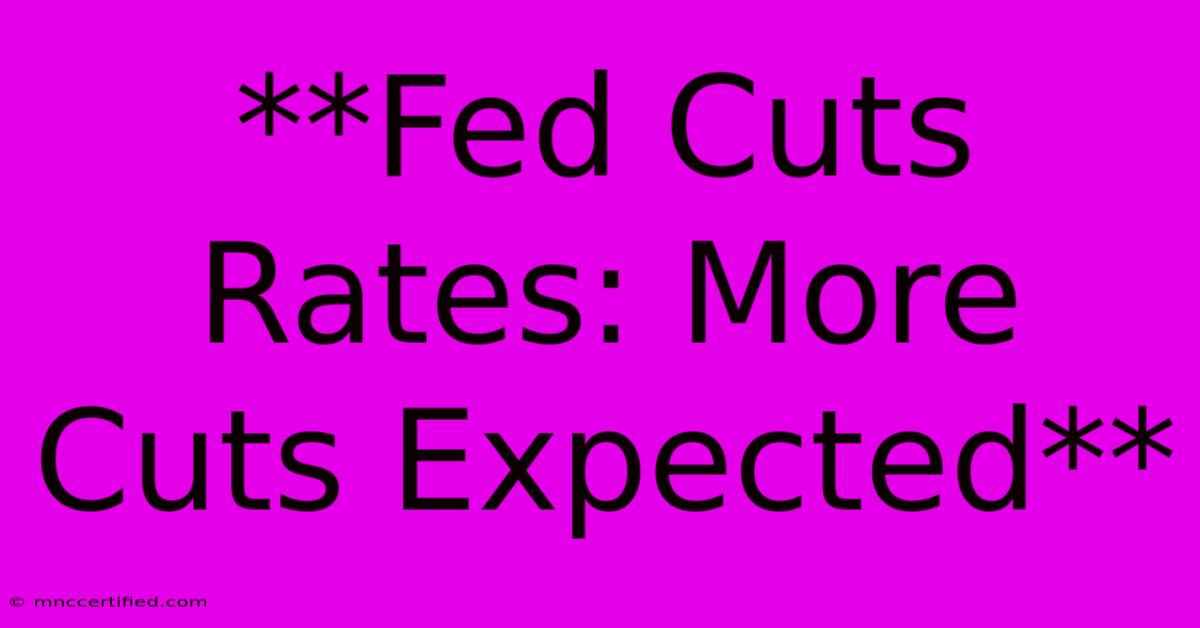**Fed Cuts Rates: More Cuts Expected**

Table of Contents
Fed Cuts Rates: More Cuts Expected, But What Does It Mean for You?
The Federal Reserve (Fed) has once again lowered interest rates, marking the second cut in as many months. This move, aimed at stimulating economic growth and countering potential recessionary pressures, has sent ripples through the financial markets and sparked discussions about the future of monetary policy. But what does this mean for you, the average person?
Why Did the Fed Cut Rates?
The Fed's decision to cut rates stems from concerns about the global economic outlook. The ongoing trade war between the US and China, coupled with slowing growth in Europe and other major economies, has created a climate of uncertainty. Additionally, the Fed is closely monitoring inflation, which has remained stubbornly below its target rate of 2%.
By lowering interest rates, the Fed hopes to encourage borrowing and spending, ultimately boosting economic activity. Lower rates make it cheaper for businesses to take out loans and invest, while consumers are more likely to borrow for large purchases like homes or cars.
What Does This Mean for You?
The impact of the Fed's rate cuts on you depends on your individual financial situation and how you manage your money. Here are some potential implications:
- Lower interest rates on savings accounts: As the Fed lowers rates, banks are likely to follow suit, offering lower interest rates on savings accounts and certificates of deposit (CDs). This means your savings may grow at a slower pace.
- Lower mortgage rates: The good news is that lower interest rates can translate into lower mortgage rates. If you're looking to buy a home or refinance your existing mortgage, you could potentially save money on your monthly payments.
- Potential for higher stock prices: Lower rates often boost stock prices as investors become more optimistic about economic growth and corporate profits. However, this is not guaranteed, and the stock market can be volatile.
- Increased borrowing: With lower interest rates, it may become easier to borrow money for various purposes, such as personal loans, car loans, and credit cards. However, it's crucial to remember that borrowing more money increases your debt burden, so use caution and borrow responsibly.
What's Next for Interest Rates?
The Fed has indicated that further rate cuts are possible, depending on the economic outlook. The trade war with China remains a significant risk factor, and the Fed is closely watching the situation. Additionally, global growth continues to slow, and inflation remains tame. These factors suggest that the Fed may be inclined to cut rates again in the near future.
However, it's important to note that the Fed's decisions are based on complex economic data and projections. While the current economic landscape suggests more rate cuts, the future is uncertain, and the Fed's course of action could change depending on how the economy evolves.
Staying Informed and Making Smart Financial Decisions
The Fed's rate cuts can have a significant impact on your finances. Staying informed about the economic landscape and the Fed's actions is crucial to making sound financial decisions.
- Research interest rates: Keep track of interest rates offered by different banks and financial institutions to find the best rates for your savings and loans.
- Review your debt: Consider strategies to reduce your debt burden, especially if interest rates are rising.
- Plan for your financial future: Seek guidance from financial advisors to make informed decisions about your investments and savings.
By understanding the implications of the Fed's rate cuts and making informed financial decisions, you can navigate this period of economic uncertainty and ensure your financial well-being.

Thank you for visiting our website wich cover about **Fed Cuts Rates: More Cuts Expected**. We hope the information provided has been useful to you. Feel free to contact us if you have any questions or need further assistance. See you next time and dont miss to bookmark.
Featured Posts
-
An Applicant Is Denied Insurance Because
Nov 08, 2024
-
Houshmandzadeh Sees Bright Future For Bengals
Nov 08, 2024
-
Experts Analyze Scholz Coalition Collapse Impact
Nov 08, 2024
-
How To Get Purewick Covered By Insurance
Nov 08, 2024
-
Do You Have To Have Snowmobile Insurance
Nov 08, 2024